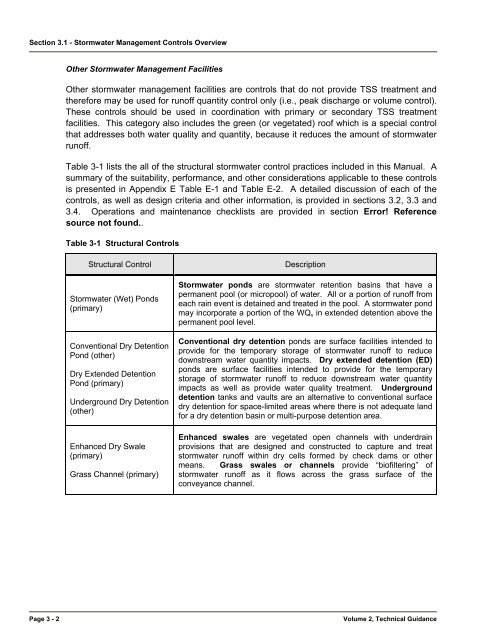Volume 2-05, Chapter 3 - City of Wichita
Volume 2-05, Chapter 3 - City of Wichita
Volume 2-05, Chapter 3 - City of Wichita
Create successful ePaper yourself
Turn your PDF publications into a flip-book with our unique Google optimized e-Paper software.
Section 3.1 - Stormwater Management Controls Overview<br />
Other Stormwater Management Facilities<br />
Other stormwater management facilities are controls that do not provide TSS treatment and<br />
therefore may be used for run<strong>of</strong>f quantity control only (i.e., peak discharge or volume control).<br />
These controls should be used in coordination with primary or secondary TSS treatment<br />
facilities. This category also includes the green (or vegetated) ro<strong>of</strong> which is a special control<br />
that addresses both water quality and quantity, because it reduces the amount <strong>of</strong> stormwater<br />
run<strong>of</strong>f.<br />
Table 3-1 lists the all <strong>of</strong> the structural stormwater control practices included in this Manual. A<br />
summary <strong>of</strong> the suitability, performance, and other considerations applicable to these controls<br />
is presented in Appendix E Table E-1 and Table E-2. A detailed discussion <strong>of</strong> each <strong>of</strong> the<br />
controls, as well as design criteria and other information, is provided in sections 3.2, 3.3 and<br />
3.4. Operations and maintenance checklists are provided in section Error! Reference<br />
source not found..<br />
Table 3-1 Structural Controls<br />
Structural Control<br />
Stormwater (Wet) Ponds<br />
(primary)<br />
Conventional Dry Detention<br />
Pond (other)<br />
Dry Extended Detention<br />
Pond (primary)<br />
Underground Dry Detention<br />
(other)<br />
Enhanced Dry Swale<br />
(primary)<br />
Grass Channel (primary)<br />
Description<br />
Stormwater ponds are stormwater retention basins that have a<br />
permanent pool (or micropool) <strong>of</strong> water. All or a portion <strong>of</strong> run<strong>of</strong>f from<br />
each rain event is detained and treated in the pool. A stormwater pond<br />
may incorporate a portion <strong>of</strong> the WQ v in extended detention above the<br />
permanent pool level.<br />
Conventional dry detention ponds are surface facilities intended to<br />
provide for the temporary storage <strong>of</strong> stormwater run<strong>of</strong>f to reduce<br />
downstream water quantity impacts. Dry extended detention (ED)<br />
ponds are surface facilities intended to provide for the temporary<br />
storage <strong>of</strong> stormwater run<strong>of</strong>f to reduce downstream water quantity<br />
impacts as well as provide water quality treatment. Underground<br />
detention tanks and vaults are an alternative to conventional surface<br />
dry detention for space-limited areas where there is not adequate land<br />
for a dry detention basin or multi-purpose detention area.<br />
Enhanced swales are vegetated open channels with underdrain<br />
provisions that are designed and constructed to capture and treat<br />
stormwater run<strong>of</strong>f within dry cells formed by check dams or other<br />
means. Grass swales or channels provide “bi<strong>of</strong>iltering” <strong>of</strong><br />
stormwater run<strong>of</strong>f as it flows across the grass surface <strong>of</strong> the<br />
conveyance channel.<br />
Page 3 - 2<br />
<strong>Volume</strong> 2, Technical Guidance
















